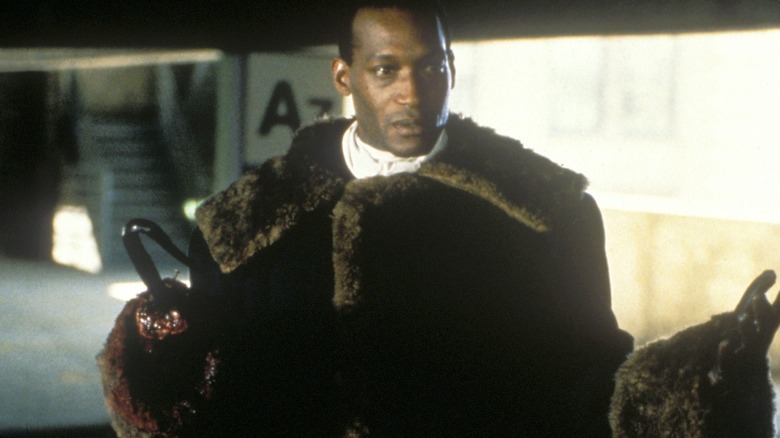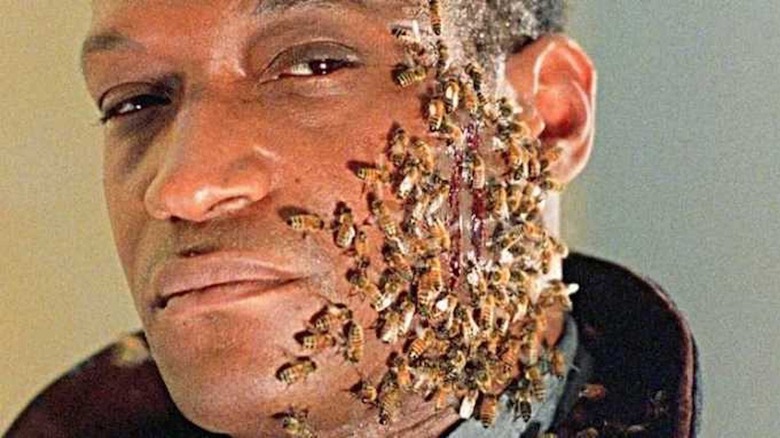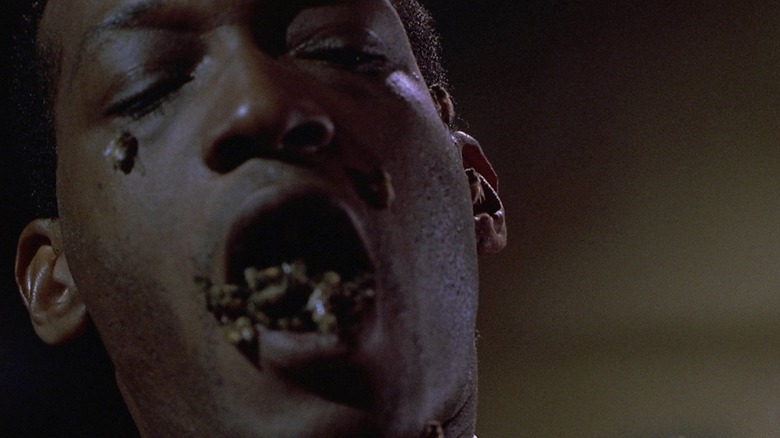Candyman’s Most Famous Moment Was Painful And Profitable For Tony Todd
Posted by admin on

Bernard Rose's 1992 film "Candyman" is based on Clive Barker's short story "The Forbidden," first published in the anthology novel "In the Flesh" in 1985. In Barker's original story, the action takes place in The Spector Street Estate, a fictional housing project in England, where a college student named Helen investigates the details of an urban legend named The Candyman. The 1992 film version of "The Forbidden" transplants the story to the very real Cabrini-Green housing development in Chicago -- a project whose history is rife with corruption and racial discrimination -- where Helen (Virginia Madsen) investigates a very similar urban myth. In both versions of the story, Helen encounters a very real Candyman (played in the film by Tony Todd), a spectral and murderous spirit of vengeance who appears behind you after you said his name five times into a mirror.
When Bernard Rose cast Tony Todd as Candyman, he asked the actor to invent a backstory for the character, as Candyman's origin was not explained in Barker's original short story. Rose revealed Todd's character treatment in the November 1992 issue of Fangoria Magazine: A man named Granville T. Candyman was the "scion of a rich Black family in 1870s Chicago." According to Todd, Granville was known for his musicianship and his skill as a painter, and was hired to paint a portrait of Helen, "the ravishing daughter of a wealthy landowner." Granville asked that Helen pose in the nude, and the two of them fall in love in the process. Their interracial affair incurs the wrath of the city who seize Granville, cut off his hand with a rusty blade, and coat his body with honey so that he may be stung to death by bees.
A very close version of Todd's treatment ended up becoming "Candyman" canon. Granville's name was changed to Daniel Robitaille, but he was still a portrait painter who had a forbidden affair with a wealthy white woman, and who was murdered by the community in an dark example of racial hatred. Now the Candyman haunts Cabrini-Green, missing a hand -- he has a bloodied hook in its place -- and bringing swarms of bees wherever he goes. Bees are an important motif of the "Candyman" films.
The Bees

In order to give "Candyman's" bees the proper amount of menace, Rose -- also the film's screenwriter -- conceived of several scenes wherein Todd would have to be covered in the insects. In one scene, Todd's face was meant to be crawling with bees. In another, his entire torso, flayed of flesh, was home to thousands of them. In one particularly horrifying shot, bees had to fly out of Todd's mouth.
Todd immediately recognized the risks of being coated in bees, and was apprehensive about exposing himself to being stung. While Hollywood insect wranglers do know how to handle bees, they can't exactly be trained in the same fashion as one would a dog or a cat. As such, to ensure the beekeepers were doing their jobs as carefully as possible, Todd negotiated a deal: He was to receive a $1,000 bonus for every time he received a bee sting. Over the course of filming, as the actor once explained to The Guardian, Todd was stung 23 times. In 1992, that was almost enough to buy a brand new Oldsmobile Cutlass Supreme.
Todd said in the Guardian that he didn't necessarily enjoy being stung, but that "Everything that's worth making has to involve some sort of pain." One can admire Todd for his work ethic, but also for his savvy negotiating skills.
How They Did It

According to a rundown in Film School Rejects, the bees in "Candyman" were specially bred for film purposes. Bee action was overseen by Norman Gary, who also handled bee action for films like 1966's "The Deadly Bees," 1991's "Fried Green Tomatoes," and the killer insects in the child-traumatizing classic "My Girl." The bees on screen were newborns -- only about 12 hours old -- and had less powerful stingers. Newborn bees also tend to be more docile and less likely to sting people, especially when exposed to bee pheromones, employed heavily during production. The pheromones tricked the bees into thinking their human co-stars were actually their queen, meaning the bees crawling around on Todd's face were actually in love with him.
In order to slip bees into Todd's mouth, the actor first inserted a dental dam, a prophylactic device typically used to practice safe oral sex. This was a practical solution, and one that Gary has employed himself; Gary currently hold's the Guinness World Record for most number of bees held in the mouth.
Candyman's exposed ribcage was merely a vest-like appliance that was filled with bees prior to shooting, and then strapped to Todd's body. Any bees on the actors bodies were retrieved using a very gentle bee vacuum cleaner that carefully sucked the bugs to safety.
While no one would deliberately allow themselves to be stung 23 times, it proved to be profitable for Todd, and rewarding for the audience: "Candyman" remains terrifying to this day, its dreamy imagery and racial commentary well-remembered by its many fans. "Candyman" was followed by three sequels in 1995's "Candyman: Farewell to the Flesh," 1999's "Candyman: Day of the Dead" and 2021's "Candyman."
Read this next: Horror Roles That Changed Actors Forever
The post Candyman's Most Famous Moment Was Painful and Profitable for Tony Todd appeared first on /Film.
